child seat MAZDA MODEL MX-5 MIATA RF 2020 User Guide
[x] Cancel search | Manufacturer: MAZDA, Model Year: 2020, Model line: MODEL MX-5 MIATA RF, Model: MAZDA MODEL MX-5 MIATA RF 2020Pages: 566, PDF Size: 62.47 MB
Page 37 of 566
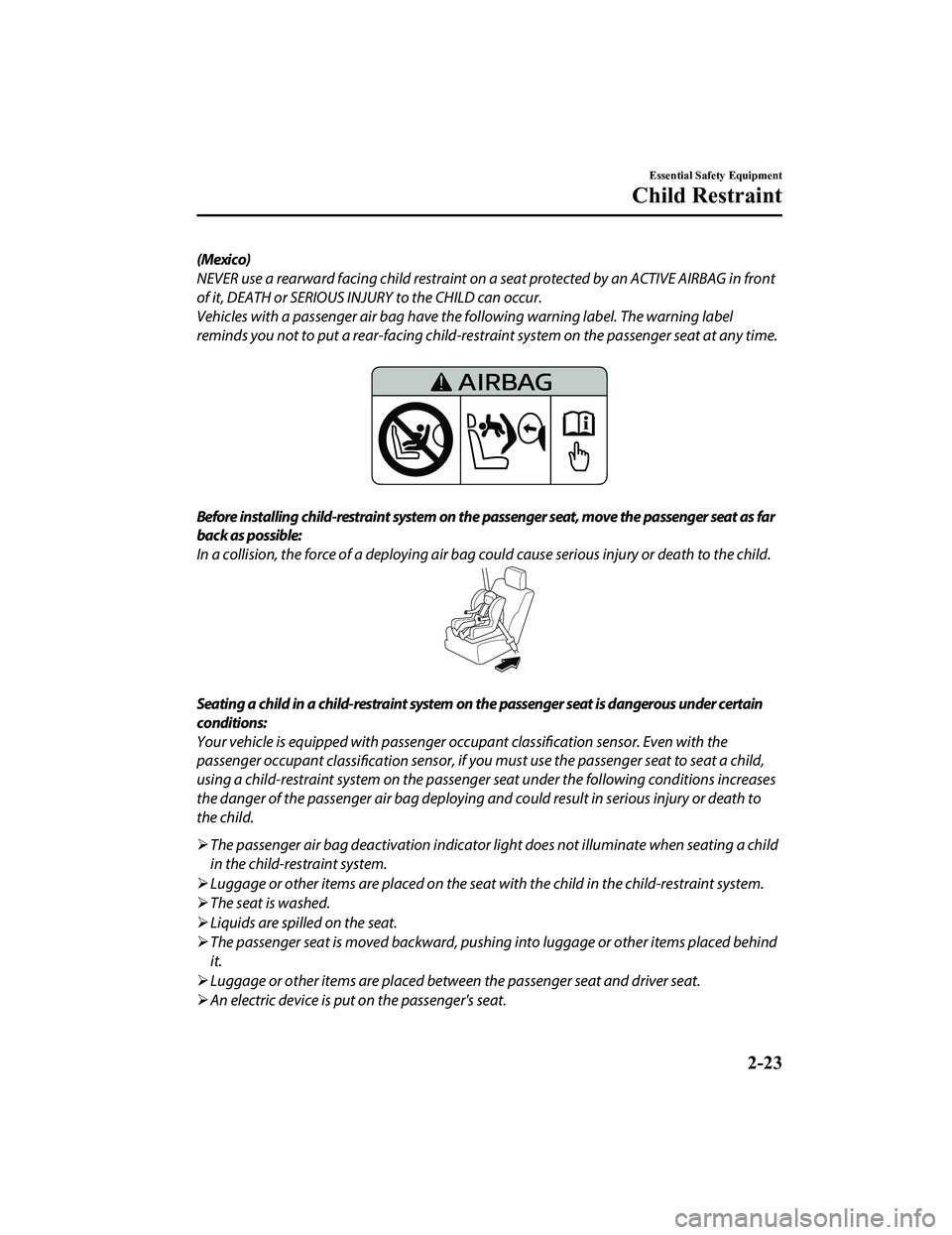
(Mexico)
NEVER use a rearward facing child restraint on a seat protected by an ACTIVE AIRBAG in front
of it, DEATH or SERIOUS INJURY to the CHILD can occur.
Vehicles with a passenger air bag have the following warning label. The warning label
reminds you not to put a rear-facing child-restraint system on the passenger seat at any time.
Before installing child-restraint system on the passenger seat, move the passenger seat as far
back as possible:
In a collision, the force of a deploying air bag could cause serious injury or death to the child.
Seating a child in a child-restraint system on the passenger seat is dangerous under certain
conditions:
Your vehicle is equipped with passenger occupant classification sensor. Even with the
passenger occupant classification sensor, if you must use the passenger seat to seat a child,
using a child-restraint system on the passenger seat under the following conditions increases
the danger of the passenger air bag deploying and could result in serious injury or death to
the child.
The passenger air bag deactivation indicator ligh t does not illuminate when seating a child
in the child-restraint system.
Luggage or other items are placed on the seat with the child in the child-restraint system.
The seat is washed.
Liquids are spilled on the seat.
The passenger seat is moved backward, pushing into luggage or other items placed behind
it.
Luggage or other items are placed between the passenger seat and driver seat.
An electric device is put on the passenger's seat.
Essential Safety Equipment
Child Restraint
2-23
MX-5_8JA4-EA-19K_Edition1_old 2019-8-29 16:18:06
Page 38 of 566
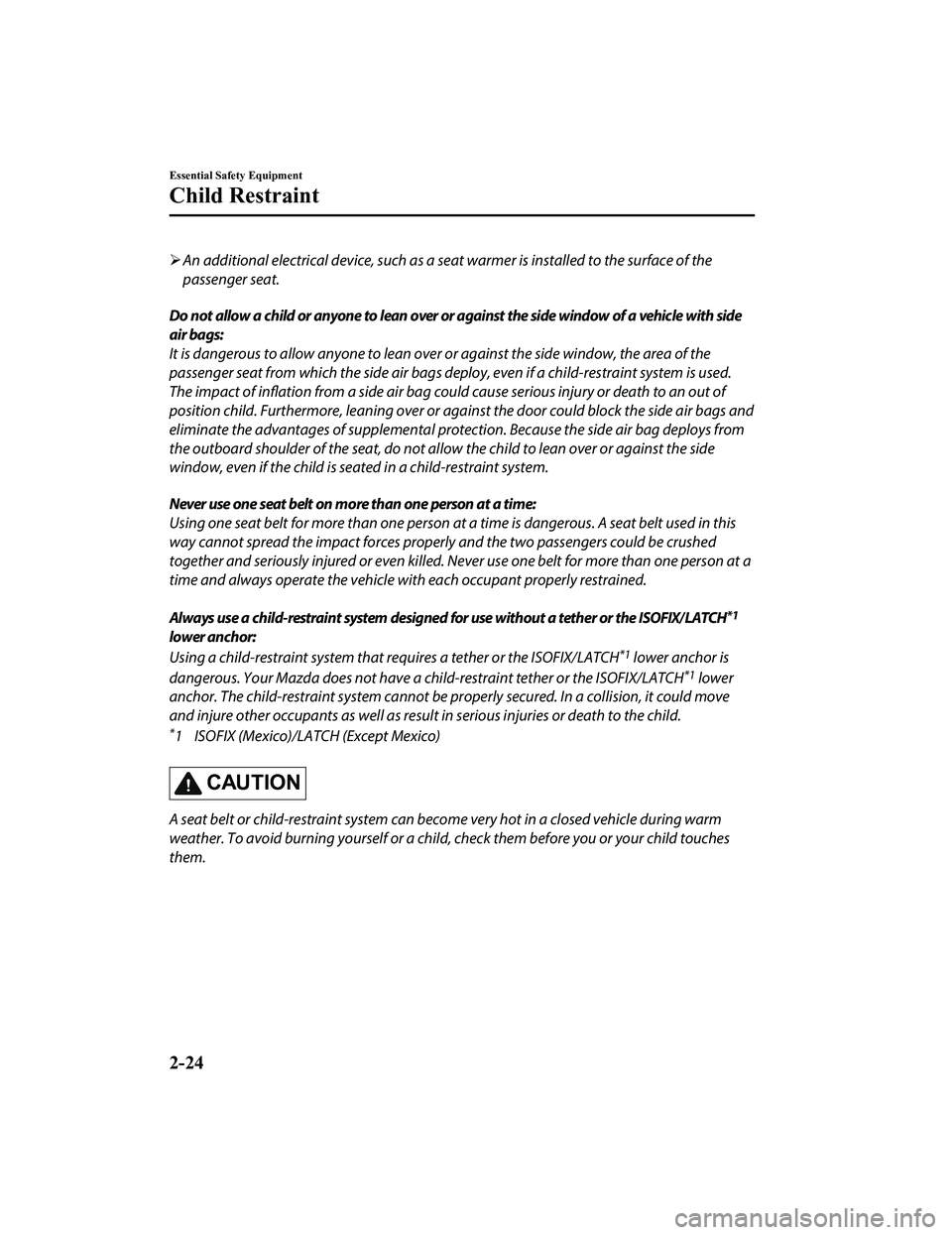
An additional electrical device , such as a seat warmer is installed to the surface of the
passenger seat.
Do not allow a child or anyone to lean over or against the side window of a vehicle with side
air bags:
It is dangerous to allow anyone to lean over or against the side window, the area of the
passenger seat from which the side air bags depl oy, even if a child-restraint system is used.
The impact of inflation from a side air bag co uld cause serious injury or death to an out of
position child. Furthermore, leaning over or ag ainst the door could block the side air bags and
eliminate the advantages of su pplemental protection. Because the side air bag deploys from
the outboard shoulder of the seat, do not allow the child to lean over or against the side
window, even if the child is seated in a child-restraint system.
Never use one seat belt on more than one person at a time:
Using one seat belt for more than one person at a time is dangerous. A seat belt used in this
way cannot spread the impact forces properly and the two passengers could be crushed
together and seriously injured or even killed. Never use one belt for more than one person at a
time and always operate the vehicle with each occupant properly restrained.
Always use a child-restraint system designed for use without a tether or the ISOFIX/LATCH
*1
lower anchor:
Using a child-restraint system that requires a tether or the ISOFIX/LATCH
*1 lower anchor is
dangerous. Your Mazda does not have a ch ild-restraint tether or the ISOFIX/LATCH
*1 lower
anchor. The child-restraint system cannot be pr operly secured. In a collision, it could move
and injure other occupants as well as result in serious injuries or death to the child.
*1 ISOFIX (Mexico)/LATCH (Except Mexico)
CAUTION
A seat belt or child-restraint system can beco me very hot in a closed vehicle during warm
weather. To avoid burning yourself or a child, check them before you or your child touches
them.
Essential Safety Equipment
Child Restraint
2-24
MX-5_8JA4-EA-19K_Edition1_old 2019-8-29 16:18:06
Page 39 of 566
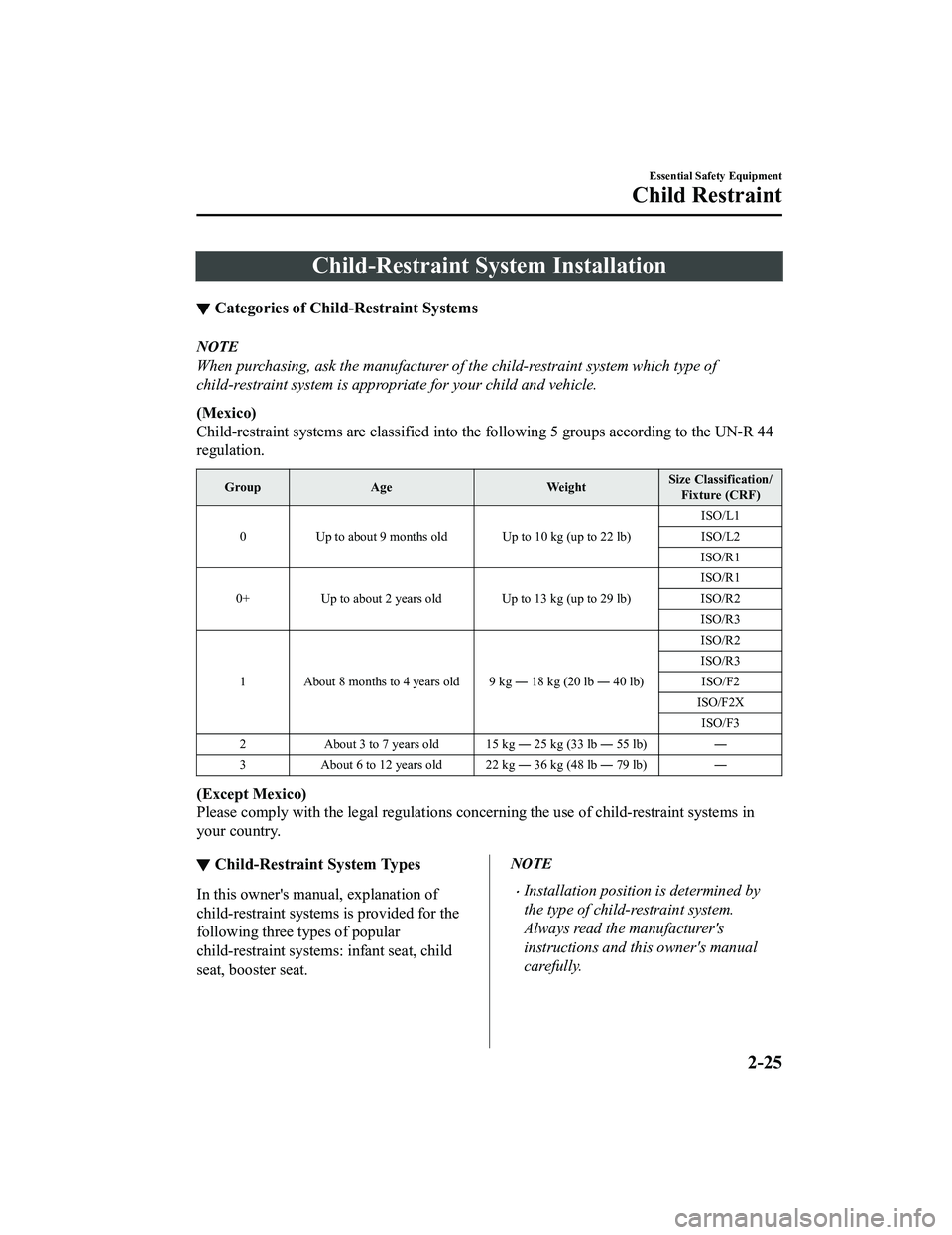
Child-Restraint System Installation
▼Categories of Child-Restraint Systems
NOTE
When purchasing, ask the manufacturer of the child-restraint system which type of
child-restraint system is appropriate for your child and vehicle.
(Mexico)
Child-restraint systems are clas
sified into the following 5 groups according to the UN-R 44
regulation.
Group Age WeightSize Classification/
Fixture (CRF)
0 Up to about 9 months old Up to 10 kg (up to 22 lb) ISO/L1
ISO/L2
ISO/R1
0+ Up to about 2 years old Up to 13 kg (up to 29 lb) ISO/R1
ISO/R2
ISO/R3
1 About 8 months to 4 years old 9 kg ― 18 kg (20 lb ― 40 lb) ISO/R2
ISO/R3
ISO/F2
ISO/F2X ISO/F3
2 About 3 to 7 years old 15 kg ― 25 kg (33 lb ― 55 lb) ―
3 About 6 to 12 years old 22 kg ― 36 kg (48 lb ― 79 lb) ―
(Except Mexico)
Please comply with the legal regulations concerning the use of child-restraint systems in
your country.
▼ Child-Restraint System Types
In this owner's manual, explanation of
child-restraint systems is provided for the
following three types of popular
child-restraint systems: infant seat, child
seat, booster seat.
NOTE
Installation position is determined by
the type of child-restraint system.
Always read the manufacturer's
instructions and this owner's manual
carefully.
Essential Safety Equipment
Child Restraint
2-25
MX-5_8JA4-EA-19K_Edition1_old
2019-8-29 16:18:06
Page 40 of 566
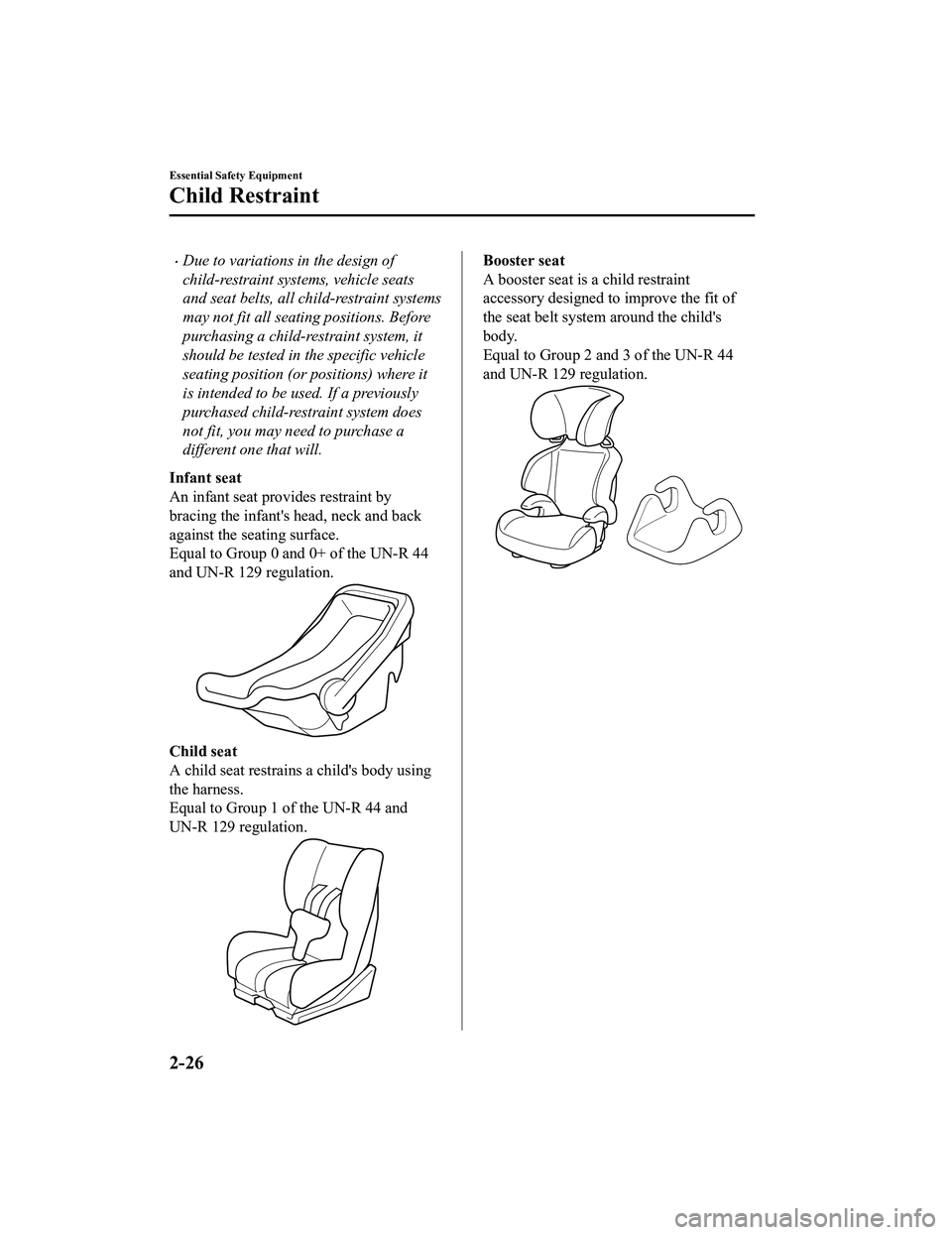
Due to variations in the design of
child-restraint systems, vehicle seats
and seat belts, all child-restraint systems
may not fit all seating positions. Before
purchasing a child-restraint system, it
should be tested in the specific vehicle
seating position (or positions) where it
is intended to be used. If a previously
purchased child-restraint system does
not fit, you may need to purchase a
different one that will.
Infant seat
An infant seat provides restraint by
bracing the infant's head, neck and back
against the seating surface.
Equal to Group 0 and 0+ of the UN-R 44
and UN-R 129 regulation.
Child seat
A child seat restrains a child's body using
the harness.
Equal to Group 1 o f the UN-R 44 and
UN-R 129 regulation.
Booster seat
A booster seat is a child restraint
accessory designed to improve the fit of
the seat belt system around the child's
body.
Equal to Group 2 and 3 of the UN-R 44
and UN-R 129 regulation.
Essential Safety Equipment
Child Restraint
2-26
MX-5_8JA4-EA-19K_Edition1_old 2019-8-29 16:18:06
Page 41 of 566

Child-Restraint System Suitability for Various Seat
Positions Table
(Mexico)
Provided information in the tabl e shows your child-restraint system suitability for various
seating position. For installation suitability of other manufac turer child-restraint system,
carefully consult the manufacture r's instructions which accompany the child-restraint
system.
When installing a child-restraint system, the following points must be observed:
When installing a child-restraint system to the passenger seat, adjust the seat slide position
as far back as possible.
Refer to Adjusting the Passenger's Seat on page 2-10.
When it is difficult to install a child-restraint system to the passenger seat, or the seat belt
cannot be secured to the child-restraint system, perform the fo llowing operations to adjust
the seat holding the child-restra int system so that the seat belt can be secured completely
to it.
Move the seat forward or back.
Move the seatback forward or back.
An i-Size child-restra int system refers to a child-restraint sy stem which has acquired
i-Size category certification fo r the UN-R 129 regulation.
When installing a child-restraint system to the passenger seat, refer to the child-restraint
system manufacturer's instructions.
Seating position Passenger
Airbag activated Airbag de-activated
Seating position suitable for univer‐
sal belted (Yes/No) Ye s ( U F )
Ye s ( U )
i-Size seating position (Yes/No) NoNo
Largest suitable rearward facing fix‐
ture (R1) No
No
Largest suitable rearward facing fix‐
ture (R2) No
No
Largest suitable rearward facing fix‐
ture (R2X) No
No
Largest suitable rearward facing fix‐
ture (R3) No
No
Largest suitable forward facing fix‐
ture (F2) No
Yes (IUF)
Essential Safety Equipment
Child Restraint
2-27
MX-5_8JA4-EA-19K_Edition1_old 2019-8-29 16:18:06
Page 42 of 566
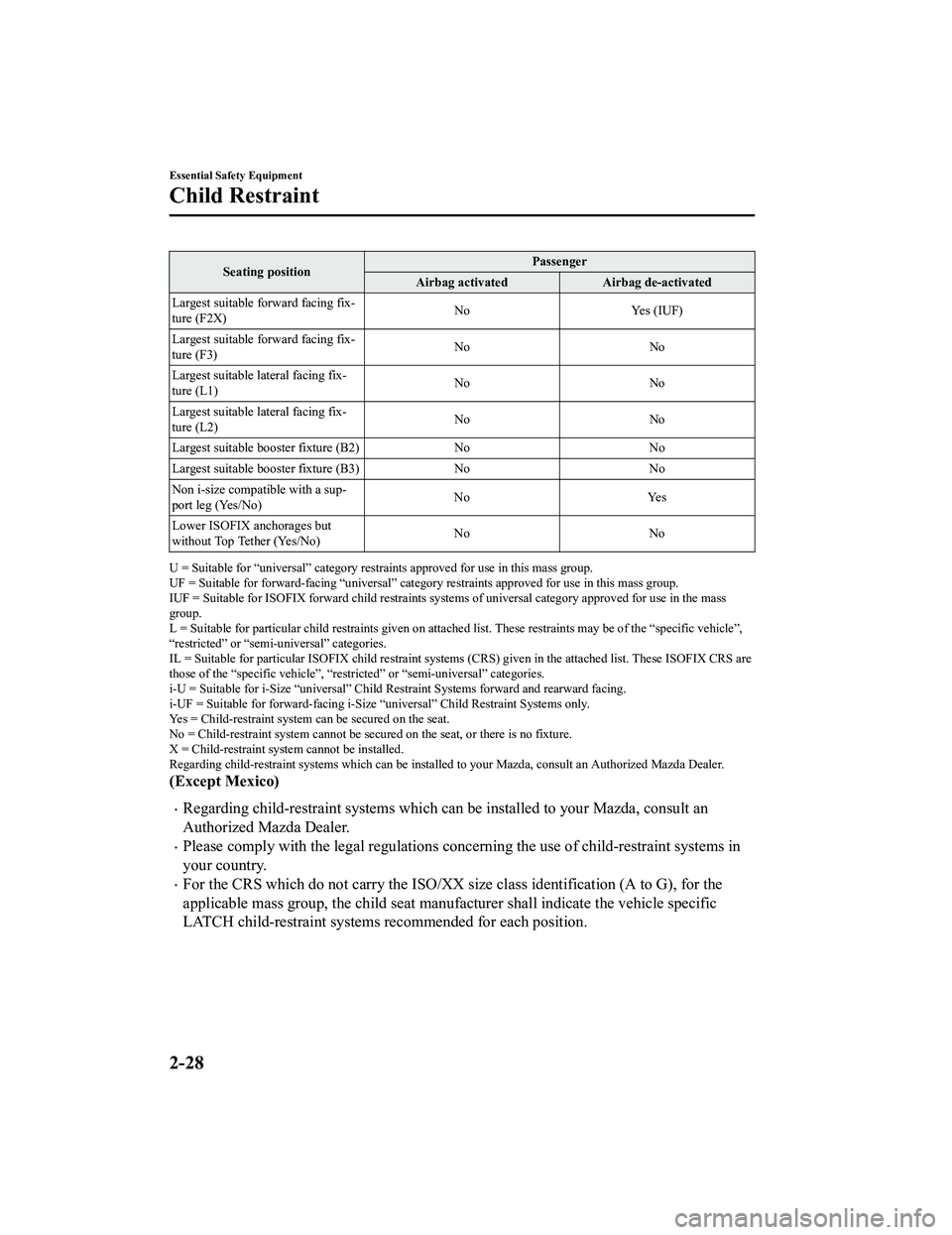
Seating positionPassenger
Airbag activated Airbag de-activated
Largest suitable forward facing fix‐
ture (F2X) No
Yes (IUF)
Largest suitable forward facing fix‐
ture (F3) No
No
Largest suitable lateral facing fix‐
ture (L1) No
No
Largest suitable lateral facing fix‐
ture (L2) No
No
Largest suitable booster fixture (B2) NoNo
Largest suitable booster fixture (B3) NoNo
Non i-size compatible with a sup‐
port leg (Yes/No) No
Yes
Lower ISOFIX anchorages but
without Top Tether (Yes/No) No
No
U = Suitable for “universal” category restraints approved for u se in this mass group.
UF = Suitable for forward-facing “universal” category restraints approved for use in this mass group.
IUF = Suitable for ISOFIX forward child restraints systems of universal category approved for use in the mass
group.
L = Suitable for particular child restraints given on attached list. These restraints may be of the “specific vehicle”,
“restricted” or “semi- universal” categories.
IL = Suitable for particular ISO FIX child restraint systems (CR S) given in the attached list. These ISOFIX CRS are
those of the “specific vehicle”, “restricted” or “semi-universal” categories.
i-U = Suitable for i-Size “univers al” Child Restraint Systems forward and rearward facing.
i-UF = Suitable for forward-facing i-Size “universal” Child Res traint Systems only.
Yes = Child-restraint system can be secured on the seat.
No = Child-restraint system can not be secured on the seat, or there is no fixture.
X = Child-restraint system cannot be installed.
Regarding child-restraint systems which can be installed to your Mazda, consult an Authorized Mazda Dealer.
(Except Mexico)
Regarding child-restraint system s which can be installed to your Mazda, consult an
Authorized Mazda Dealer.
Please comply with the legal regulations concerning the use of child-restraint systems in
your country.
For the CRS which do not carry t he ISO/XX size class identification (A to G), for the
applicable mass group, the child seat manufacturer shall indicate the vehicle specific
LATCH child-restraint systems recommended for each position.
Essential Safety Equipment
Child Restraint
2-28
MX-5_8JA4-EA-19K_Edition1_old 2019-8-29 16:18:06
Page 43 of 566
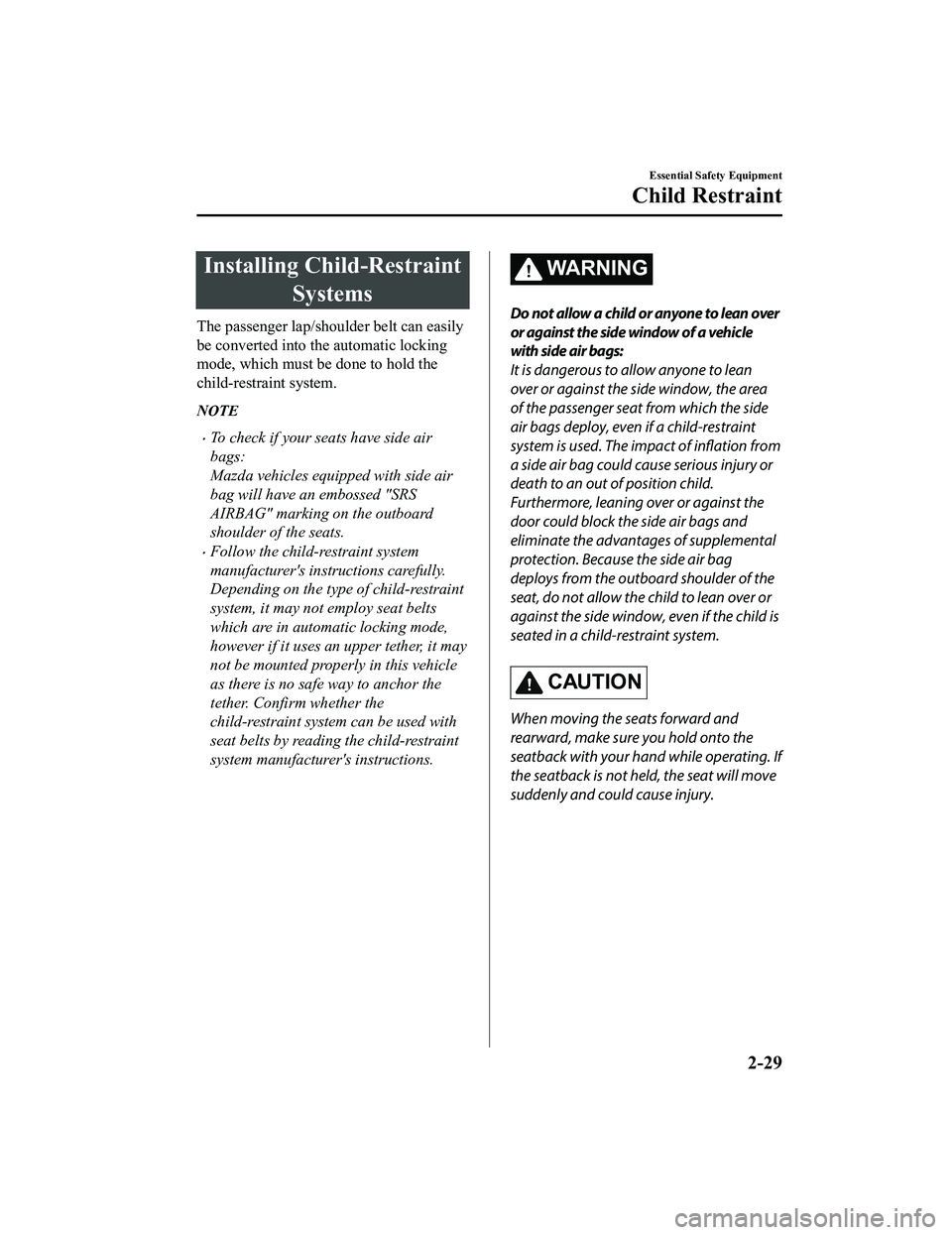
Installing Child-RestraintSystems
The passenger lap/shoulder belt can easily
be converted into the automatic locking
mode, which must be done to hold the
child-restraint system.
NOTE
To check if your seats have side air
bags:
Mazda vehicles equipped with side air
bag will have an embossed "SRS
AIRBAG" marking on the outboard
shoulder of the seats.
Follow the child-restraint system
manufacturer's instructions carefully.
Depending on the type of child-restraint
system, it may not employ seat belts
which are in automatic locking mode,
however if it uses an upper tether, it may
not be mounted properly in this vehicle
as there is no safe way to anchor the
tether. Confirm whether the
child-restraint system can be used with
seat belts by reading the child-restraint
system manufacturer's instructions.
WA R N I N G
Do not allow a child or anyone to lean over
or against the side window of a vehicle
with side air bags:
It is dangerous to allow anyone to lean
over or against the side window, the area
of the passenger seat from which the side
air bags deploy, even if a child-restraint
system is used. The impact of inflation from
a side air bag could cause serious injury or
death to an out of position child.
Furthermore, leaning over or against the
door could block the side air bags and
eliminate the advantages of supplemental
protection. Because the side air bag
deploys from the outboard shoulder of the
seat, do not allow the child to lean over or
against the side window, even if the child is
seated in a child-restraint system.
CAUTION
When moving the seats forward and
rearward, make sure you hold onto the
seatback with your hand while operating. If
the seatback is not he ld, the seat will move
suddenly and could cause injury.
Essential Safety Equipment
Child Restraint
2-29
MX-5_8JA4-EA-19K_Edition1_old 2019-8-29 16:18:06
Page 44 of 566
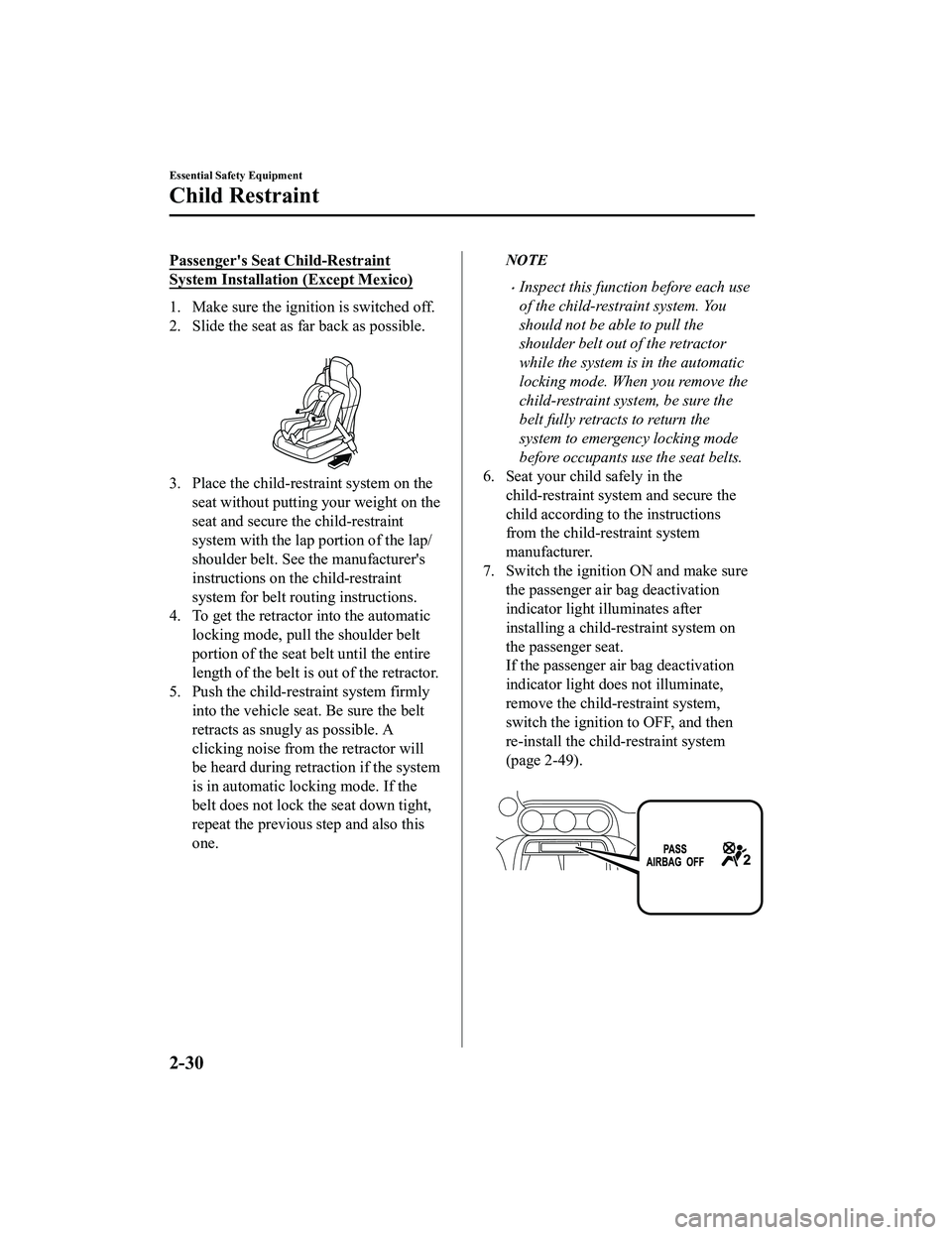
Passenger's Seat Child-Restraint
System Installation (Except Mexico)
1. Make sure the ignition is switched off.
2. Slide the seat as far back as possible.
3. Place the child-res traint system on the
seat without putting your weight on the
seat and secure the child-restraint
system with the lap portion of the lap/
shoulder belt. See the manufacturer's
instructions on the child-restraint
system for belt routing instructions.
4. To get the retractor into the automatic
locking mode, pull the shoulder belt
portion of the seat belt until the entire
length of the belt is out of the retractor.
5. Push the child-restraint system firmly into the vehicle sea t. Be sure the belt
retracts as snugly as possible. A
clicking noise from the retractor will
be heard during retraction if the system
is in automatic lo cking mode. If the
belt does not lock the seat down tight,
repeat the previous step and also this
one.
NOTE
Inspect this function before each use
of the child-restraint system. You
should not be able to pull the
shoulder belt out of the retractor
while the system is in the automatic
locking mode. When you remove the
child-restraint system, be sure the
belt fully retracts to return the
system to emergency locking mode
before occupants use the seat belts.
6. Seat your child safely in the child-restraint system and secure the
child according to the instructions
from the child-restraint system
manufacturer.
7. Switch the ignition ON and make sure the passenger air bag deactivation
indicator light illuminates after
installing a child-restraint system on
the passenger seat.
If the passenger a ir bag deactivation
indicator light does not illuminate,
remove the child-restraint system,
switch the ignition to OFF, and then
re-install the chil d-restraint system
(page 2-49).
Essential Safety Equipment
Child Restraint
2-30
MX-5_8JA4-EA-19K_Edition1_old 2019-8-29 16:18:06
Page 45 of 566
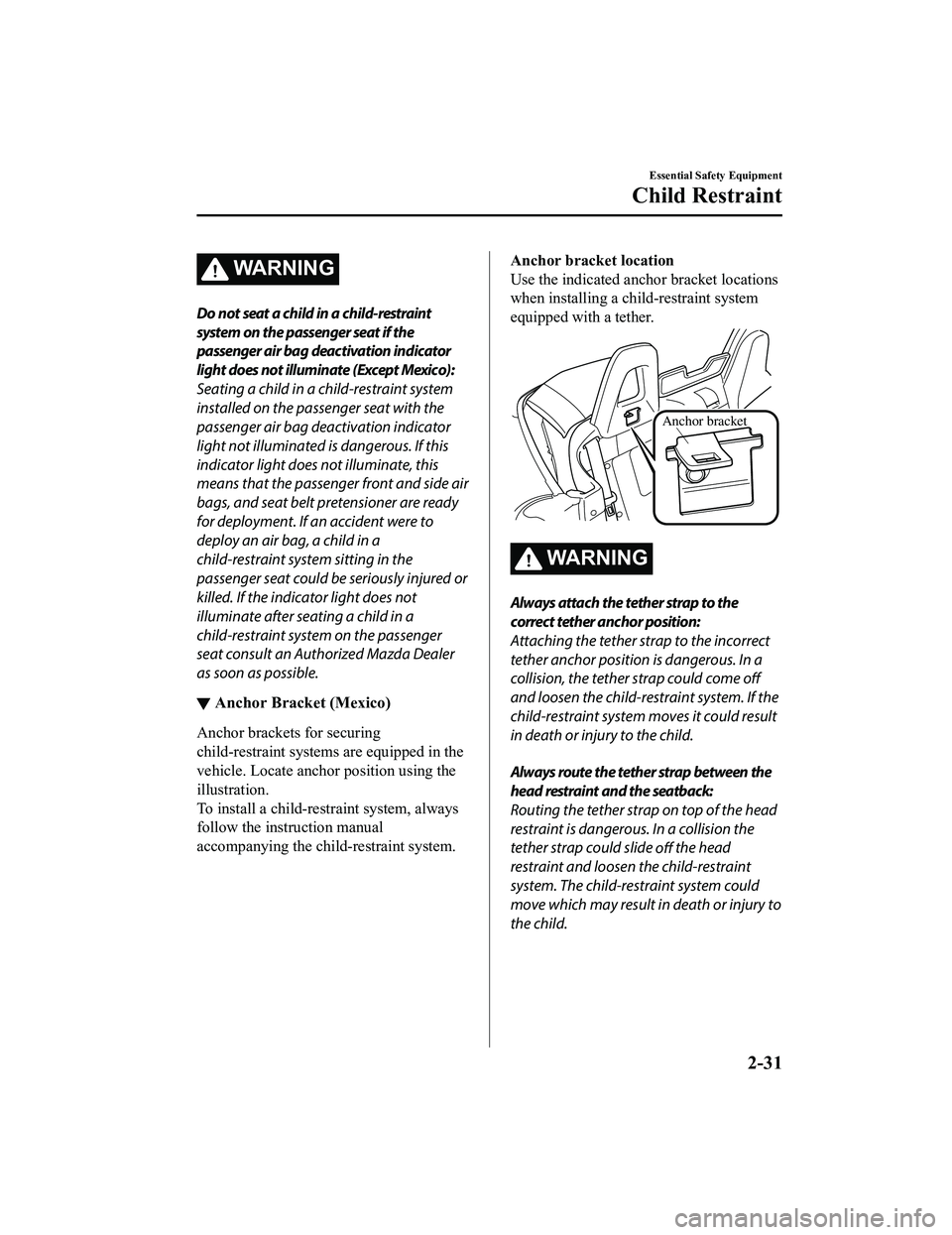
WA R N I N G
Do not seat a child in a child-restraint
system on the passenger seat if the
passenger air bag deactivation indicator
light does not illuminate (Except Mexico):
Seating a child in a child-restraint system
installed on the passenger seat with the
passenger air bag deactivation indicator
light not illuminated is dangerous. If this
indicator light does not illuminate, this
means that the passenger front and side air
bags, and seat belt pretensioner are ready
for deployment. If an accident were to
deploy an air bag, a child in a
child-restraint system sitting in the
passenger seat could be seriously injured or
killed. If the indicator light does not
illuminate after seating a child in a
child-restraint system on the passenger
seat consult an Authorized Mazda Dealer
as soon as possible.
▼Anchor Bracket (Mexico)
Anchor brackets for securing
child-restraint systems are equipped in the
vehicle. Locate anchor position using the
illustration.
To install a child-restraint system, always
follow the instruction manual
accompanying the child-restraint system.
Anchor bracket location
Use the indicated anchor bracket locations
when installing a child-restraint system
equipped with a tether.
Anchor bracket
WA R N I N G
Always attach the tether strap to the
correct tether anchor position:
Attaching the tether strap to the incorrect
tether anchor position is dangerous. In a
collision, the tether strap could come off
and loosen the child-restraint system. If the
child-restraint system moves it could result
in death or injury to the child.
Always route the tether strap between the
head restraint and the seatback:
Routing the tether strap on top of the head
restraint is dangerous. In a collision the
tether strap could slide
off the head
restraint and loosen the child-restraint
system. The child-restraint system could
move which may result in death or injury to
the child.
Essential Safety Equipment
Child Restraint
2-31
MX-5_8JA4-EA-19K_Edition1_old 2019-8-29 16:18:06
Page 46 of 566
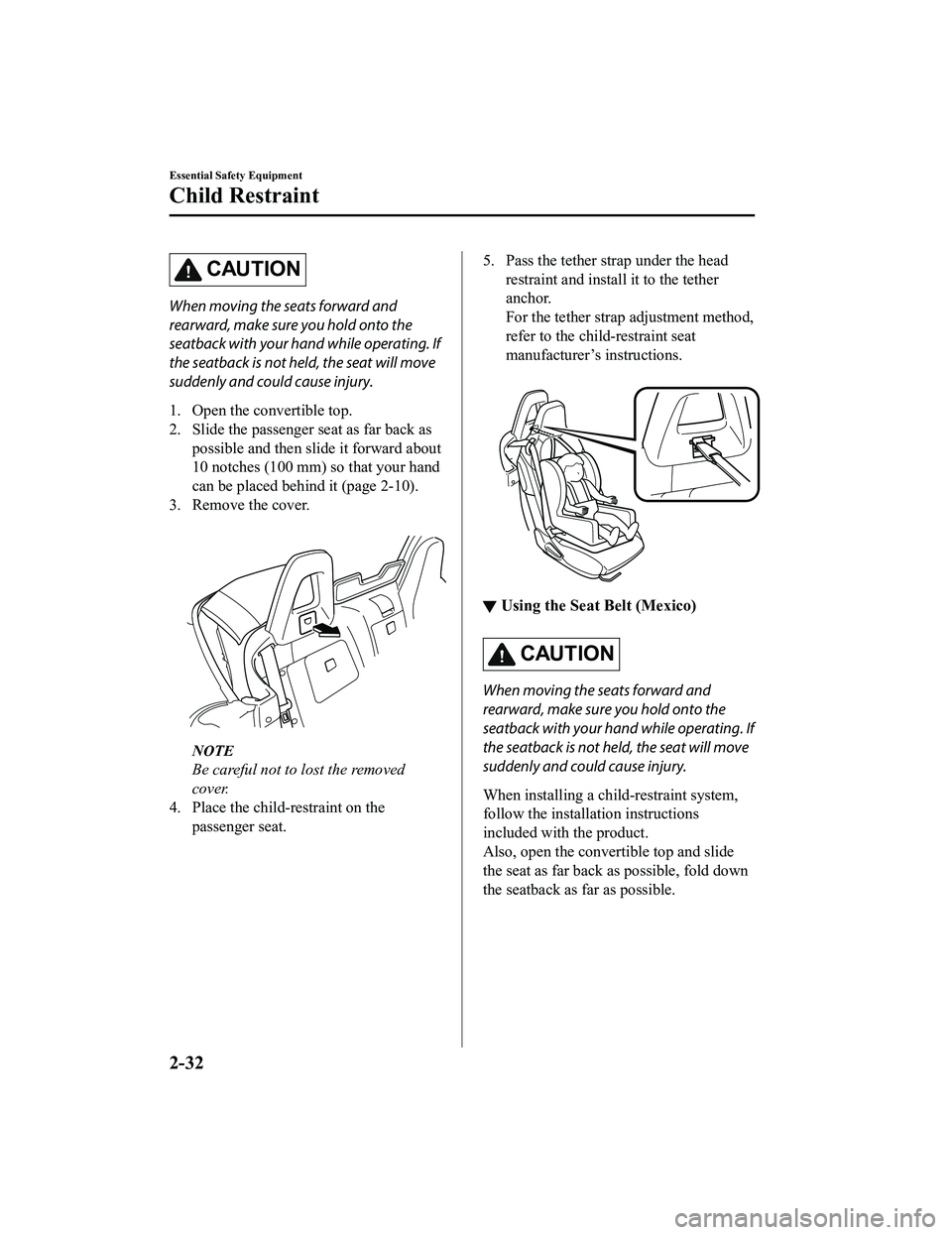
CAUTION
When moving the seats forward and
rearward, make sure you hold onto the
seatback with your hand while operating. If
the seatback is not held, the seat will move
suddenly and could cause injury.
1. Open the convertible top.
2. Slide the passenger seat as far back aspossible and then slide it forward about
10 notches (100 mm) so that your hand
can be placed behind it (page 2-10).
3. Remove the cover.
NOTE
Be careful not to lost the removed
cover.
4. Place the child- restraint on the
passenger seat.
5. Pass the tether strap under the head
restraint and install it to the tether
anchor.
For the tether strap adjustment method,
refer to the child-restraint seat
manufacturer’s instructions.
▼ Using the Seat Belt (Mexico)
CAUTION
When moving the seats forward and
rearward, make sure you hold onto the
seatback with your hand while operating. If
the seatback is not held, the seat will move
suddenly and could cause injury.
When installing a child-restraint system,
follow the installation instructions
included with the product.
Also, open the convertible top and slide
the seat as far back as possible, fold down
the seatback as far as possible.
Essential Safety Equipment
Child Restraint
2-32
MX-5_8JA4-EA-19K_Edition1_old
2019-8-29 16:18:06